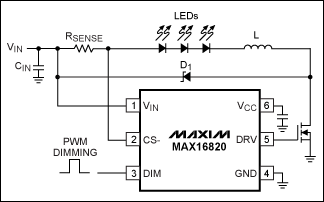

MAX16820典型应用电路图
LED电路
115人已加入
描述
For several LEDs in series, the sum of their VF voltages can go to 40V or more, and if not referenced to ground, that VF sum requires a differential measurement. As a third challenge (in addition to high voltage and differential measurement), HBLEDs are often dimmed using pulse-width modulation (PWM). If so, you can't measure VF during the low portion of the PWM duty cycle, when the LEDs are not illuminated and VF is not present. For a hysteretic buck LED driver (MAX16820) driving three LEDs in series (Figure 1), you must measure the anode and cathode voltages of the string when DIM is high.

Figure 1. Standard driver circuit for HB LEDs.
To avoid the need for a differential high-voltage measurement, you can take the indirect approach of measuring the duty cycle at the DRV pin. For this particular LED driver, a first-order estimate of forward voltage for the LED string is VF = D × VIN, where D represents an internal duty cycle produced in the IC's switchmode section (not to be confused with the duty cycle at DIM). The DRV signal is referenced to ground and limited to VCC (5V). That condition allows the use of low voltage ADCs or comparators, which in turn can be powered by the LED driver's VCC output (10mA maximum).
打开APP阅读更多精彩内容

Figure 1. Standard driver circuit for HB LEDs.
To avoid the need for a differential high-voltage measurement, you can take the indirect approach of measuring the duty cycle at the DRV pin. For this particular LED driver, a first-order estimate of forward voltage for the LED string is VF = D × VIN, where D represents an internal duty cycle produced in the IC's switchmode section (not to be confused with the duty cycle at DIM). The DRV signal is referenced to ground and limited to VCC (5V). That condition allows the use of low voltage ADCs or comparators, which in turn can be powered by the LED driver's VCC output (10mA maximum).
声明:本文内容及配图由入驻作者撰写或者入驻合作网站授权转载。文章观点仅代表作者本人,不代表电子发烧友网立场。文章及其配图仅供工程师学习之用,如有内容侵权或者其他违规问题,请联系本站处理。
举报投诉
- 相关推荐
- 热点推荐
- MAX16820
-
LED驱动电路MAX16820相关资料分享2021-04-01 1301
-
MAX14895E典型应用电路图2011-09-03 2798
-
MAX1840, MAX1841典型应用电路图2011-08-06 3928
-
典型应用电路图2009-06-22 5510
-
MAX619典型应用电路图2009-05-13 1006
-
BAH系列典型应用电路图2009-05-11 885
-
MAX16820的外部电感和检流电阻的设计工具2009-05-09 1378
-
MAX16818应用电路图2009-03-31 1219
-
采用MAX16820 LED驱动器构建的5W MR16 LE2009-02-07 1753
-
MAX16819-MAX16820中文资料pdf2008-06-30 1904
-
max7219应用电路图2008-04-26 2451
-
max639典型应用电路图大全2007-12-03 1731
全部0条评论

快来发表一下你的评论吧 !

